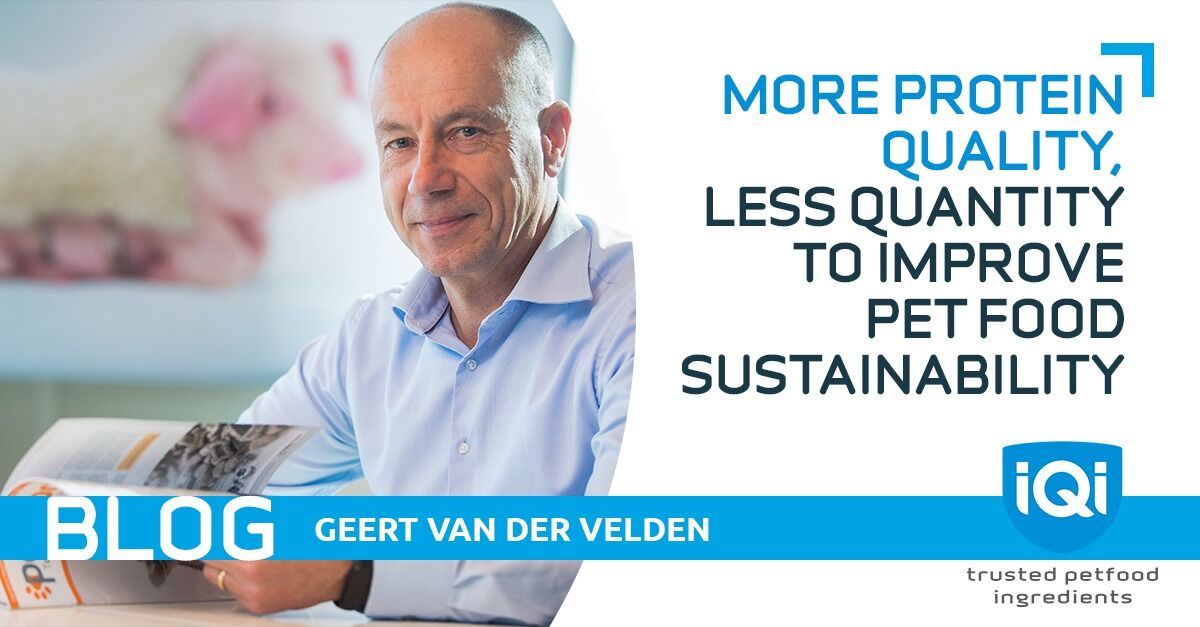

Your region has been set to
Change region
Close


Your region has been set to
Change region
Close



June 09 2022 - News
Human food trends are always reflected in the pet food industry. In recent years, we have seen grain-free and paleo diets, for example, resulting in pet food with increasing amounts of protein. But there is no point in manufacturing pet food with more protein than a cat or dog can digest or needs nutritionally – and it doesn’t help sustainability either. So, let’s start looking at quality over quantity.
Achieving nutritional sustainability, as defined by the UN, means that food needs to provide sufficient energy and essential nutrients to maintain good health in a population without compromising the ability of future generations to meet their nutritional needs. In the pet food industry, that means we need to ensure that cats and dogs get exactly the nutrition they require. Structurally adding more protein than they can digest creates an unnecessarily high carbon footprint for pet food products.
Maximizing the amount of protein doesn’t necessarily mean more nutrients for the animal. While growing puppies and kittens need larger amounts of protein to grow and develop, this need decreases as the animals reach maturity and until they reach seniority. In one of my previous blogs, I explained that senior cats and dogs require sufficient intake of high-quality, highly digestible protein to compensate for decreasing digestibility. As true carnivores, cats have a higher protein requirement than dogs. Cats require at least 31% of the total digestible protein to be highly digestible protein and preferably over 36% total protein of high quality. The requirement for dogs is that at least 21% of total digestible protein should be highly digestible protein and total protein should be no less than 24%.
Our industry should focus on using the right amount of protein of high quality with a complete amino acid profile and excellent protein digestibility of more than 83%. Studies have shown egg protein to have the highest protein efficiency ratio and the most complete amino acid profile, followed by chicken and other animal-based proteins, and then plant-based proteins. Enzymatic hydrolysis, spray-drying, and other low-temperature drying steps result in proteins of the highest quality with the highest digestibility, whereby all proteins and nutrients are preserved.
Protein sources with the highest digestibility include spray-dried pure whole egg powder, hydrolyzed fish proteins, hydrolyzed animal proteins (such as chicken products), spray-dried fish meal, fresh meat of good quality, and highly digestible vegetable proteins. Of the various spray-dried animal proteins available, those of poultry origin have the highest acceptance in the market, are the most versatile, are very palatable, and offer several benefits for the health and well-being of cats and dogs.
Good examples of highly digestible poultry sources of protein are:
Plant-based proteins available for pet food applications are among the most sustainable options and can be applied in hybrid or even vegan diets, as I explained in one of my previous blogs. Potato protein, for example, has a protein content of 75% and excellent digestibility. Other examples with good digestibility include wheat gluten (82% protein), chickpeas (70% protein), corn gluten (60% protein), and non-GMO soy (55-70% protein). More novel plant-based protein sources that have recently been introduced onto the pet food market include hemp (60-70% protein), algae (60% protein), and single-cell protein (70% protein). There can be big differences, however, in digestibility and amino acid profiles. This may mean supplementation is required, especially of taurine.
Achieving nutritional sustainability of pet food with a well-balanced choice of ingredients is an important step in moving towards a more sustainable pet food industry. To learn more about IQI Trusted Petfood Ingredients’ vision on sustainability, please download our e-paper.
Geert van der Velden is IQI Trusted Petfood Ingredients’ Innovation Manager responsible for Business Development, generating new products and concepts that meet the needs of existing and new customers. Geert has more than 25 years’ experience in the international pet food industry and has gained knowledge and experience in many sections of IQI’s business.
